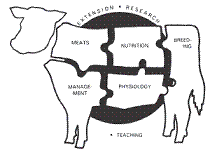Animal Science, Department of

Nebraska Beef Cattle Reports
Date of this Version
2023
Citation
2023 Nebraska Beef Cattle Report
UNL Beef, Institute of Agriculture and Natural Resources, University of Nebraska-Lincoln
Abstract
A 3-yr study utilized 300 Angus-based, spring-born heifers to evaluate postweaning heifer development systems on gain and reproductive performance. Three groups of heifers were developed over the winter development period either grazing winter range or fed a dry lot diet targeted to 1.5 lb/d of gain in order to achieve 65% of their mature body weight at breeding. Thirty days prior to artificial insemination, heifers grazing winter rand entered the dry lot and were fed this same diet, one group of dry lot heifers remained on this diet, and the other received increased energy in the form of wet corn gluten feed. Post development body weight and average daily gain were greater among dry lot developed heifers. There were no differences in artificial insemination or final pregnancy rate. Results indicate that producers may use a 30-day increase in energy prior to artificial insemination to decrease overall development inputs in range heifers without compromising reproductive efficiency when compared to dry lot heifers receiving greater inputs.
Included in
Large or Food Animal and Equine Medicine Commons, Meat Science Commons, Veterinary Preventive Medicine, Epidemiology, and Public Health Commons

